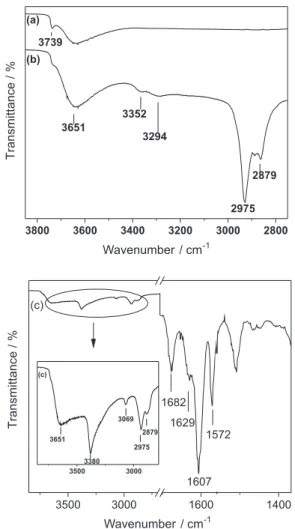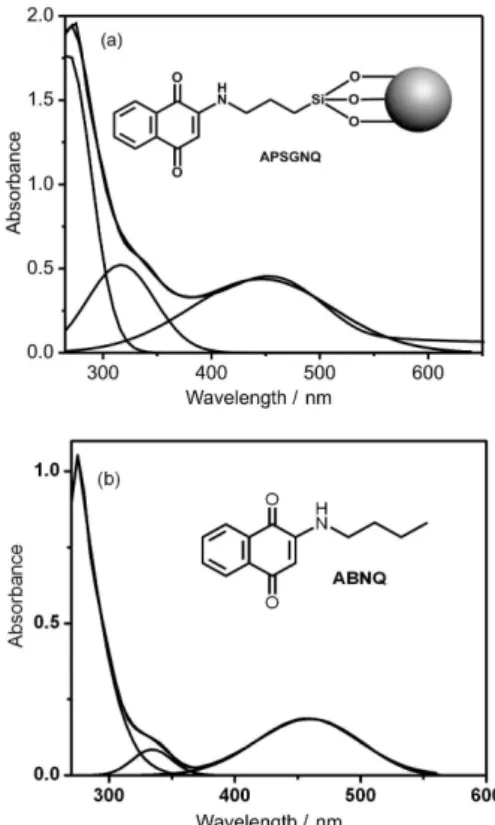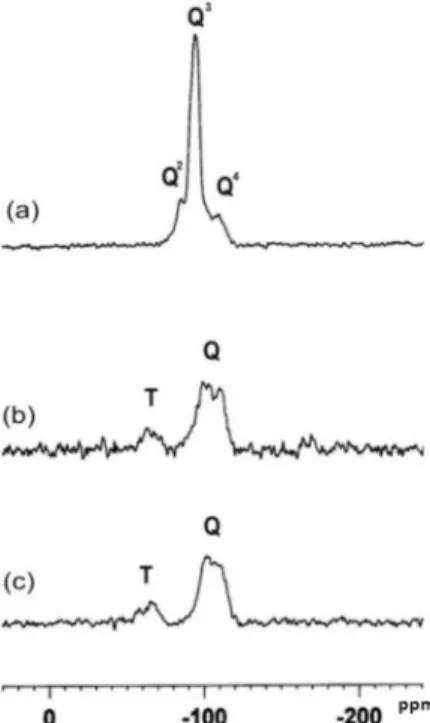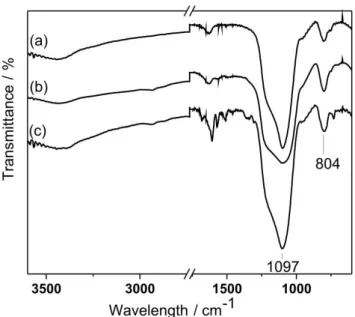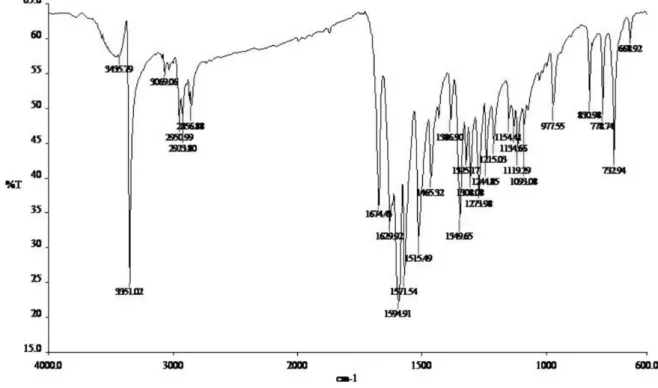Article
J. Braz. Chem. Soc., Vol. 22, No. 5, 961-967, 2011. Printed in Brazil - ©2011 Sociedade Brasileira de Química
0103 - 5053 $6.00+0.00
A
*e-mail: mdvargas@vm.uff.br, cmronconi@vm.uff.br
Modiied Silica Nanoparticles with an Aminonaphthoquinone
Gleiciani Q. Silveira,a Célia M. Ronconi,*,a Maria D. Vargas,*,a Rosane A. S. San Gilb
and Alvicler Magalhãesc,d
aInstituto de Química, Universidade Federal Fluminense, Campus do Valonguinho,
Centro, 24020-150 Niterói-RJ, Brazil
bInstituto de Química, Universidade Federal do Rio de Janeiro, Ilha do Fundão,
21945-970 Rio de Janeiro-RJ, Brazil
cInstituto Oswaldo Cruz, FIOCRUZ, CP 926, 21045-900 Rio de Janeiro-RJ, Brazil
dInstituto de Química, Universidade Estadual de Campinas, CP 6154,
13083-970 Campinas-SP, Brazil
Nanopartículas de sílica (NPs) modiicadas covalentemente com uma aminonaftoquinona foram sintetizadas e caracterizadas. A aminopropilsilicagelnaftoquinona (APSGNQ) foi obtida por substituição nucleofílica do grupo metóxi da 2-metóxi-1,4-naftoquinona por NPs modiicadas com o grupo aminopropil (APSG). Os espectros de ressonância magnética nuclear de 13C e 29Si no estado
sólido conirmaram que a naftoquinona encontra-se ligada covalentemente à aminopropilsilicagel. Como o composto APSGNQ é solúvel em solventes orgânicos comuns, foi possível quantiicar o ancoramento da naftoquinona na superfície das NPs modiicadas por espectroscopia no ultravioleta-visível (0,56 mmol de naftoquinona ancorada por grama de APSGNQ), por comparação com o espectro do composto análogo 2-aminobutil-1,4-naftoquinona (ABNQ). Os dados das análises elementares indicaram que aproximadamente 8% da propilamina presente na superfície do composto APSGNQ não reagiu com a metóxinaftoquinona. Essas NPs de sílica multifuncionais têm potencial para aplicações médicas.
The synthesis and characterization of silica nanoparticles (NPs) covalently modiied with an aminonaphthoquinone are reported. The aminopropylsilicagelnaphthoquinone (APSGNQ) was obtained by nucleophilic substitution of 2-methoxy-1,4-naphthoquinone with aminopropylsilicalgel (APSG) NPs. Solid state 13C and 29Si nuclear magnetic resonance spectra conirmed that the
naphthoquinone is covalently bonded to APSG. Due to the solubility of APSGNQ in common organic solvents, solution ultraviolet-visible spectroscopy was used to determine the amount of naphthoquinone on the NPs surface (0.56 mmol of incorporated naphthoquinone per gram of APSGNQ) by comparison with the spectrum of 2-aminobutyl-1,4-naphthoquinone (ABNQ). Elemental analysis indicated that about 8% of the surface propylamine remained unreacted in APSGNQ. These multifunctional silica NPs have potential in medical applications.
Keywords: multifunctional material, silica nanoparticles, naphthoquinones, solid state 13C
and 29Si NMR
Introduction
Silica nanoparticles (NPs) modified with organic groups have been studied extensively.1-3 A large
number of silanes carrying different organic functional groups have been used for the silica NPs surface modification,4 e.g., 3-aminopropyltriethoxysilane2 and
3-iodopropyltrimethoxysilane.3,5 Amorphous silica NPs
present high thermal and chemical stability and high surface area, which allows a variety of interactions with other materials.6 The modiied compounds differ signiicantly
from the original matrix and may have various technological applications, such as support for drug delivery,7 biosensors,8
biomarkers,9 magnetic devices,7 fabrication of electric and
thermal insulators10and in photodynamic therapy,11 among
interesting for medical applications because they present low toxicity,12are biocompatible12,13 and can be excreted
in the urine.14
The work described herein involves the modiication of silica NPs surface with 3-aminopropyltriethoxysilane for the incorporation of naphthoquinones. This class of compounds exhibits a wide range of biological properties, e.g., bactericide,15 fungicide,16trypanocidal,17
antimalarial,18 antileishmanial,18 anticancer,19,20
antitubercular21 and against Aedes aegypti.22 These
biological activities have been associated to the interference of quinones in the electron transport chain by electron reduction processes, generating semiquinone radical (Q•
) and hydroquinone anion (Q2−
).23 The presence
of amino groups has been shown to potentiate some of these biological activities.20,24
Herein we describe the successful anchoring of an aminonaphthoquinone on silica NPs. To the best of our knowledge, NPs containing covalently-bound naphtoquinones have not yet been reported in the literature.
Experimental
Materials and methods
The silica nanoparticles (NPs) (Aldrich, 15 nm, 637238) were pretreated under high vacuum at 180 °C for 10 h to remove adsorbed water. 3-Aminopropyltriethoxysilane and butylamine, both from Aldrich, were used without prior treatment. Toluene (Vetec) was previously dried with sodium/benzophenone under argon; methanol and ethanol were used as received. 2-(3-Butylamino)-1,4-naphthoquinone25 and 2-methoxy-1,4-naphthoquinone26
were prepared according to the literature. Transmission infrared (IR) spectra were obtained from KBr pellets with a FTIR Spectrum One (Perkin Elmer) spectrophotometer. IR diffuse relectance (DRIFT) spectra were obtained with a FTIR Spectrum One (Perkin Elmer) spectrometer coupled to: i) a Praying Mantis Harrick, which consists of a domo of three windows (two KBr and a quartz) that protects the sample, ii) a Harrick Scientiic ATC-124 model temperature controller and iii) a Matheson 8270 model argon low controller (30 cm3 min−1). Thermogravimetric analyses were
conducted with a Netzsch STA 409 PC TG/DTA equipment. Approximately 10 mg of sample were weighed in an alumina crucible and heated at 35-1100 °C, at the heating
rate of 5 °C min−1, under nitrogen low (30 cm3 min−1).
Elemental analyses were carried out at the Central Analítica of the Instituto de Química, Universidade de São Paulo, Brazil. Solid-state 13C and 29Si NMR experiments were
performed on a Bruker DRX300 spectrometer (7.05 T),
operating at Larmor frequencies of 75.4 and 59.3 MHz respectively and equipped with a 4 mm Bruker CPMAS probe and ZrO2 rotors, spinning at 6 kHz (13C) and 5 kHz
(29Si). For 13C NMR spectra, the 1H-13C cross polarisation
magic angle spinning (CPMAS) pulse sequence was employed, with optimised contact time of 2 ms and a repetition time (D1) of 4 s. 29Si MAS NMR spectra
were acquired by using both 1H-29Si cross polarisation
(CPMAS) with contact time of 4 ms27 and direct polarisation
with high power 1H dipolar decoupling (HPDD) pulse
sequences. In this case experiments were performed by using repetition times from 10 to 300 s based on literature data for similar samples.28 The results obtained with
commercial silica NPs indicated that the repetition time of 60 s could be used to obtain quantitative Si spectra with enough signal-to-noise ratio to integrate the spectra. The external references used for the chemical shifts were the CH3 signal of hexamethylbenzene at 17.3 ppm for
13C and
the Q3 Si sites of caulinite at −91.5 ppm for 29Si. UV-Vis
spectra were obtained with a diode array 8452A (Hewlett Packard - HP) spectrophotometer in spectroscopic grade dimethylsulfoxide (dmso).
Synthesis of the silica nanoparticles modified with aminopropyl groups (APSG) and functionalized with naphthoquinone groups (APSGNQ)
The reaction is illustrated in Scheme 1. Modiication of the NPs surface with the aminopropyl group2 was carried out
by addition of 3-aminopropyltriethoxysilane (APTES) (3 g, 13.5 mmol) to a suspension of silica NPs (3 g) in reluxing toluene (50.0 mL) under stirring and argon atmosphere. After 1.5 h, a small ethanol-containing toluene fraction was distilled off and more 3-aminopropyltriethoxysilane (1.05 g, 4.78 mmol) was added to the toluene suspension. This procedure was repeated 3 times. After the reaction mixture was cooled down to room temperature, the white solid was iltered off and washed copiously in a Soxhlet apparatus with CH2Cl2 (500 mL) and acetone (500 mL).
The white solid (APSG) was then collected and dried under vacuum at 60 °C (yield: 2.9 g).
Results and Discussion
FTIR spectra
FTIR analyses of the previously heated NPs, APSG and of the inal product APSGNQ (Scheme 1) were carried out at room temperature (Figure S1, Supplemantary Information - SI). Diffuse reflectance FTIR (DRIFT) spectra were obtained after heating at 180 °C under N
2 for
20 min (Figure 1), in order to remove all adsorbed water from the surface. The presence of water was evidenced in the spectra obtained at 100° and 150 °C.
The bands at about 1097 and 804 cm−1 refer
to asymmetric and symmetric Si−O−Si stretches, respectively, which dominate the spectra of all samples (Figure S1, SI). The main differences between the spectra of NPs and APSG (Figures 1a and b, respectively) were due to the bands attributed to ν(C−H) stretches, clearly identiied at 2975 and 2879 cm−1, and weak bands due
to ν(N−H) stretches at 3352 and 3294 cm−1, associated
to the presence of the aminopropyl group. Incorporation of the naphthoquinone to APSG (Figure 1c) resulted in the appearance, in the spectrum of APSGNQ, of bands at 3380, 1682 and 1607 cm−1 assigned to ν(N−H), ν(C=O)
and ν(C=C) stretches, respectively; the ν(N−H) band
could only be observed upon heating the sample at 180 °C, due to the presence of the stretching vibration
band of adsorbed water, ν(O−H), observed at 3444 cm−1.
As expected the infrared spectra of APSGNQ and of a pure sample of ABNQ are very similar (Figure S2, SI) thus conirming the anchoring of the naphthoquinone moiety.
Figure 1. DRIFT spectra of (a) NPs, (b) APSG and (c) APSGNQ. The samples were heated at 180 °C under N2 for 20 min prior to spectra collection.
Scheme 1. (a) Functionalization of the NPs surface with amino groups,2 followed by reaction of APSG with 2-methoxy-1,4-naphthoquinone (MNQ); (b) reaction of MNQ with butylamine to give ABNQ, for the purpose of comparison. APSG and APSGNQ pictures are idealized models, i.e., formation of oligomers and polymers on the silica surface is not shown for the sake of clarity.
Elemental and thermogravimetric analyses
The nitrogen contents in the APSG and APSGNQ samples were assessed from elemental analysis and in the irst case also by argentometry,30and the results
are summarized in Table 1. Elemental analysis31 and
argentometry of APSG gave respectively 0.61 and 0.59 mmol g−1 of amine groups on the surface. Considering
be assigned to both decomposition of the aminopropyl groups and thermal condensation of residual silanol groups. The total weight loss at 1100 °C was 11.0, 19.0 and 17.0% for the silica NPs, APSG and APSGNQ samples respectively.
UV-Vis spectra
Quantification of the naphthoquinone content in APSGNQ was carried out by UV-Vis spectroscopy measurements. Both APSGNQ and ungrafted ABNQ were soluble in common organic solvents and exhibited very similar spectra. The spectra of APSGNQ (1.2 mg per 10 mL of dmso) and of ABNQ in the same solvent (2.86 × 10−5 mol L−1, Figure 3) showed a band around 334 nm
corresponding to the aromatic system π−π* transitions, and a broad band in the visible region around 457 nm due to the quinone carbonyls n−π* transition.32 The naphthoquinone
concentration in the APSGNQ solution was determined using the absorption band in the visible region, which resulted in 0.56 mmol of incorporated naphthoquinone per gram of APSGNQ. This result is in accordance with the elemental analyses and suggests that about 8% of the surface propylamine remained unreacted in APSGNQ. Thus, UV-Vis spectroscopy has been a valuable and quick method to determine the naphthoquinone content in this material.
Figure 4 shows the 29Si CPMAS spectra obtained
for the NPs, APSG and APSGNQ samples, whereas the
13C CPMAS spectra obtained for APSG, APSGNQ and
2-methoxy-1,4-naphthoquinone are depicted in Figure 5. With the pulse sequence employed (see Experimental), the 29Si and 13C signals are related to the magnitude of
the dipolar interaction with protons, which depends on geometrical factors, namely, the 1H-29Si and 1H-13C
internuclear distances, respectively, by factors rSi-3 H and rC
-3 H.
In this way Q4, Q3 and Q229Si sites are observed. Similarly,
in the 13C NMR spectra, protonated and non-protonated
carbon atoms can be observed.33
In the 29Si CPMAS spectrum of NPs (Figure 4a),
signals due to SiO2(OH)2 (Q2 sites) at −84 ppm, SiO3–OH
(Q3 sites) at −96 ppm and SiO 4 (Q
4 sites) at −111 ppm
were observed. The spectra of APSG and APSGNQ (Figures 4b and c, respectively) indicated the absence of the Q2 sites and showed the presence of Tn sites: in
the −50 to −60 ppm range (T2 site, C−Si(OSi)
2OH), and
−60 to −75 ppm (T3 site, C−Si(OSi)
3), in addition to
the Q3 and Q4 sites, at −98 and −107 ppm, respectively,
thus conirming the presence of the aminopropyl group covalently bound to the silica NPs.34 The relative
increase in the intensity of peak Q4 in the spectrum
of APSG in comparison with that of NPs (Figures 4b and c, respectively) indicates that further condensation
Table 1. Results of elemental analyses and calculated amine concentration in APSG and APSGNQ samples
Sample Elemental content Amine concentration
(mmol g−1)a
C% N% C/N
(expected)
APSG 2.19 0.85 3.00 (3.00) 0.59
APSGNQ 6.01 0.64 10.8 (13.00) N. D.b aArgentometry; b not determined.
Figure 2. Thermogravimetric curves of (a) silica NPs, (b) APSG and (c) APSGNQ.
has also occurred between unreacted hydroxy groups of silane molecules bound to the silica surface and hydrolyzed ethoxy groups from APTS or from bound –OSi(OEt)×(CH2)3NH2, resulting in oligomerized and
polymerized layers, as described previously.29
The concentration of functional groups in APSG and APSGNQ was measured from the relative intensities of Tn
and Qn silicon groups observed by 29Si MAS NMR under
direct polarization and high power proton decoupling. The
results indicated in both cases that about 3 molar % of Si–O sites corresponded to Tn sites, i.e., that 3% of silicon
atoms were bound to aminopropyl groups. This value, which is lower than those given by elemental analysis and argentometry (see above), is probably obtained because the low aminopropyl content of both materials makes quantitative analysis dificult.
13C CPMAS spectra of APSG and APSGNQ
(Figures 5a and b) conirmed the results obtained from the
29Si CPMAS NMR spectra. The carbon chemical shifts
of CH2−NH2 (44 ppm), C−CH2−C (23 ppm) and CH2−Si
(11 ppm) in the spectrum of APSG are similar to those obtained by Rahman et al.35 The spectrum of APSGNQ
exhibits the resonances of APSG together with a peak due to CH2−NH-naphthoquinone (52 ppm) and those attributed
to the naphthoquinone carbon atoms, thus confirming the presence of unreacted amine groups. The spectrum of 2-methoxy-1,4-naphthoquinone (MNQ) was included for comparison (Figure 5c) and presented well resolved signals, evidencing the crystalline nature of this compound. Displacement of the methoxy group by the surface amine of APSG was conirmed by the absence, in the spectrum of APSGNQ, of the peak associated to the MNQ O−CH3 carbon,
at 58 ppm, besides the clear shift of the Car−O signal at
161 ppm, in the spectrum of MNQ, to 149 ppm in the spectrum of APSGNQ. Furthermore, shifts of the signals attributed to the C=O groups (at 185 and 180 ppm) and Car (between 120
and 140 ppm) are also observed. We conclude, therefore, that the incorporation of 1,4-naphthoquinones onto modiied silica NPs is easily carried out via the same route used for the synthesis of amino-substituted 1,4-naphthoquinones.26,36
The fact that some amine groups remained unreacted might be associated to the oligomerization or polymerization of silane molecules bound to the silica surface (see above NMR discussion)29 making it dificult for the amine to react with
the naphthoquinone.
Conclusions
Our work has demonstrated that the reaction of aminopropylsilicalgel NPs with labile 2-methoxy-1,4-naphthoquinones is a good route to silica NPs containing bound amino-naphthoquinones. The material was fully characterized by a combination of techniques that established that the 1,4-naphthoquinone is covalently bound to the silica NPs. Even though the methodology proved itself eficient, further investigation is necessary to produce material with larger amounts of aminonaphthoquinone groups on the silica surface. Considering that modification of the 1,4- and 1,2-naphthoquinone nuclei with amines has resulted in increased cytotoxic activity20 and that surface modiied
Figure 4.29Si CPMAS NMR spectra of (a) NPs, (b) APSG and (c) APSGNQsamples.
NPs can be eficiently endocytosed in vitro by a variety of mammalian cells including cancer and non cancer cells,13 it
is possible that the binding of naphthoquinone onto NPs may help to increase the concentration of this compound inside the cells and therefore its cytotoxicity.
Supplementary Information
Supplementary information associated with this paper contains the FTIR spectra of the synthesized materials. It is available free of charge at http://jbcs.sbq.org.br as PDF ile.
Acknowledgements
Authors gratefully acknowledge FAPERJ (Primeiros Projetos and Jovens Emergentes), Pronex-FAPERJ (grant number E-26/171.512/2006) and CAPES (G. Q. S. fellowship) for inancial support. M. D. V and C. M. R. are recipients of CNPq research fellowships. We thank Dr. A. Faro (IQ-UFRJ, Brazil) for the DRIFT spectra and Dr. Ana Maria Rangel de Figueiredo Teixeira and Wildson Vieira Cerqueira (IQ-UFF) for the TGA analyses.
References
1. Iler, R. K.; Colloids Surf., A1998, 142, 59.
2. Cauvel, A.; Renard, G.; Brunel, D.; J. Org. Chem. 1997, 62, 749. 3. Alauzun, J.; Mehdi, A.; Reye, C.; Corriu, R.; New J. Chem. 2007,
31, 911; Luts, T.; Suprun, W.; Hofman, D.; Klepel, O.; Papp, H.;
J. Mol. Catal. A: Chem.2007, 261, 16.
4. Jal, P. K.; Patel, S.; Mishra, B. K.; Talanta2004, 62, 1005. 5. Margelefsky, E. L.; Zeidan, R. K.; Dufaud, V.; Davis, M. E.; J. Am.
Chem. Soc. 2007, 129, 13691.
6. Okada, K.; Shimai, A.; Takei, T.; Hayashi, S.; Yasumori, A.; Mackenzie, K. J. D.; Microporous Mesoporous Mater.1998,
21, 289.
7. Hu, A. H.; Liu, T. Y.; Huang, H. Y.; Liu, D. M.; Chen, S. Y.;
Langmuir2008, 24, 239; Yang, J.; Lee, J.; Kang, J.; Lee, K.; Suh, J. S.; Yoon, H. G.; Huh, Y. M.; Haam, S.; Langmuir2008, 24,
3417; Yagüe, C.; Moros, M.; Grazú, V.; Arruebo, M.; Santamaría, J.; Chem. Eng. J.(Amsterdam, Neth.) 2008, 137, 45; Ma, H.; Zhou, J.; Caruntu, D.; Yu, M.; Chen, J. F.; Connor, C. J. O.; Zhou, W. L.;
J. Appl. Phys. 2008, 103, 07A320; Kim, S.; Ohulchanskyy, T. Y.; Pudavar, H. E.; Pandey, R.; K.; Prasad, P. N.; J. Am. Chem. Soc. 2007, 129, 2669.
8. Silva, L. B.; Baptista, P.; Raniero, L.; Doria, G.; Martins, R.; Fortunato, E.; Sens. Actuators, B2008, 132, 508; Khan, R.; Kaushik, A.; Solanki, P. R.; Ansari, A. A.; Pandey, M. K.; Malhotra, B. D.; Anal. Chim. Acta2008, 616, 207.
9. Law, W. C.; Yong, K. T.; Roy, I.; Xu, G.; Ding, H.; Bergey, E. J.; Zeng, H.; Prasad, P. N.; J. Phys. Chem. C2008, 112, 7972.
10. Wei, H.; Zhou, L.; Li, J.; Liu, J.; Wang, E.; J. Colloid Interface Sci. 2008, 321, 310; Wang, J.; Liu, G.; Wu, H.; Lin, Y.; Anal. Chim. Acta 2008, 610, 112.
11. Liong, M.; Lu, J.; Kovochich, M.; Xia, T.; Ruehm, S. G.; Nel, A. E.; Tamanoi, F.; Zink, J. I.; ACS Nano2008, 2, 889.
12. Slowing, I. I.; Wu, C. W; Vivero-Escoto, J. L.; Lin, V. S. Y.; Small 2009, 5, 57; Slowing, I. I.; Vivero-Escoto, J. L.; Lin, V. S. Y.;
J. Mater. Chem.2010, 20, 7924.
13. Slowing, I. I.; Vivero-Escoto, J. L.; Wu, C. W.; Lin, V. S. Y.; Adv. Drug Delivery Rev. 2008, 60, 1278.
14. He, X.; Nie, H.; Wang, K.; Tan, W.; Wu, X.; Zhang, P.; Anal. Chem. 2008, 80, 9597; Burns, A. A.; Vider, J.; Ow, H.; Herz, E.; Medina, O. P.; Baumgart, M.; Larson, S. M.; Wiesner, U.; Bradbury, M.;
Nano Lett.2009, 9, 442.
15. Francisco, A. I.; Vargas, M. D.; Fragoso, T. P.; Carneiro, J. W. M.; Casellato, A.; Silva, F. C.; Ferreira, V. F.; Barbosa, J. P.; Pessoa, C.; Costa-Lotufo, L. V.; Marinho Filho, J. D. B.; Moraes, M. O.; Mangrich, A. S.; J. Braz. Chem. Soc.2010, 21, 1293 and references therein.
16. Gafner, S.; Wolfender, J. -L.; Nianga, M.; Stoeckli-Evans, H.; Hostettman, K.; Phytochemistry1996, 42, 1315.
17. Kayser, O.; Kiderlen, A. F.; Laatsch, H.; Croft, S.; Acta Tropica 2000, 77, 307; Baramee, A.; Coppin, A.; Mortuaire, M.; Pelinski, L.; Tomavo, S.; Brocard, J.; Bioorg. Med. Chem. 2006, 14, 1294; Dalgliesh, C. E.; J. Am. Chem. Soc. 1949, 71, 1697; Leffer, M. T.; Hathaway, R. J.; J. Am. Chem. Soc. 1948, 70, 3222; Moura, K. C. G.; Emery, F. S.; Neves-Pinto, C.; Pinto, M. C. F. R.; Dantas, A. P.; Salomão, K.; Castro, S. L.; Pinto, A. V.; J. Braz. Chem. Soc. 2001, 12, 325; Silva Júnior, E. N.; Moura, M. A. B. S.; Pinto, A. V.; Pinto, M. C. F. R.; Souza, M. C. B. V.; Araújo, A. J.; Pessoa, C.; Costa-Lotufo, L .V.; Montenegro, R. C.; Moraes, M. O.; Ferreira, V. F.; Goulart, M. O. F.; J. Braz. Chem. Soc. 2009,
20, 635; Silva Junior, E. N.; Menna-Barreto, R. F. S.; Pinto, M. C. F. R.; Silva, E. S. F.; Teixeira, D. V.; de Souza, M. C. B. V.; Simone, C. A.; Castro, S. L.; Ferreira, V. F.; Pinto, A. V.; Eur. J. Med. Chem.2008, 43, 1774; Silva Júnior, J. N.; Souza, M. C. B. V.; Fernandes, M. C.; Menna-Barreto, R. F. S.; Pinto, M. C. F. R.; Lopes, F. A.; Simone, C. A.; Pinto, A. V.; Ferreira, V. F.; Castro, S. L.; Bioorg. Med. Chem. 2008, 16, 5030; Jorqueira, A.; Gouvêa, R. M.; Ferreira, V. F.; Silva, M. N.; Souza, M. C. B. V.; Zuma, A. A.; Cavalvanti, D. F. B.; Araújo, H. P.; Santos, D. O.; Bourguignon, S. C.; Parasitol. Res. 2006, 99, 429; Pinto, A. V.; Silva, R. S. F.; Simone, C. A.; Castro, S. L.; Smalta, V. R.; Santos, G. L.; Costa, E.; Trindade, U. L. T.; Teixeira, D. V.; Pinto, M. C. F. R.; Eur. J. Med. Chem.2006, 41, 526; Pinto, A. V.; Castro, S. L.; Menna-Barreto, R. F. S.; Dias, J. A. M.; Soares, M. J.;
J. Antimicrob. Chemother. 2005,56, 1034.
Zalis, M. G.; Carvalho, L. H.; Krettli, A. U.; Bioorg. Med. Chem. Lett.2004, 14, 1145.
19. Subramanian, S.; Ferreira, M. M. C.; Trsic, M.; Struct. Chem. 1998, 9, 47; Siripong, P.; Yahyafai, J.; Shimizu, K.; Ichikawa, S.; Asai, T.; Kanokmedakul, K.; Ruchirawat, S.; Oku, N.; Biol. Pharm. Bull.2006, 29, 2279; Chenna, P. H. D.; Benedetti-Doctorovich, V.; Baggio, R. F.; Garland, M. T.; Burton, G.; J. Med. Chem. 2001,
44, 2486; Ravelo, A. G.; Braun, A. E.; Orellana, H. C.; Sacau, E. P.; Siverio, D. M.; Curr. Top. Med. Chem.(Sharjah, United Arab Emirates) 2004, 4, 241.
20. Vargas, M. D.; Pinto, A. C.; Echevarria, A.; Esteves-Souza, A.; Camara, C. A.; Cunha, A. C.; Torres, J. C.; Lima, E. L. S.; J. Braz. Chem. Soc.2006, 17, 439; Esteves-Souza, A.; Figueiredo, D. V.; Câmara, C. A.; Vargas, M. D.; Pinto, A. C.; Echevarria, A.; Braz. J. Med. Biol. Res.2007, 40, 1399; Cunha, A. S.; Vargas, M. D.; Gattassi, C. R.; Pinto, A. C.; Camara, C. A.; Esteves-Souza, A.; Lima, E. L. S.; Oncol. Rep.2008, 20, 225; Silva Júnior, E. N.; de Deus, C. F.; Cavalcanti, B. C.; Pessoa, C.; Costa-Lotufo, L. V.; Montenegro, R. C.; de Moraes, M. O.; Pinto, M. C. F. R.; Simone, C. A.; Ferreira, V. F.; Goulart, M. O. F.; Andrade, C. K. Z.; Pinto, A. V.; J. Med. Chem.2010, 53, 504.
21. Ferreira, S. B.; Silva, F. C.; Bezerra, F. A. F. M.; Lourenço, M. C. S.; Kaiser, C. R.; Pinto, A. C.; Ferreira, V. F.; Arch. Pharm. (Weinheim, Germany)2010, 343, 81.
22. Ribeiro, K. A. L.; Carvalho, C. M.; Molina, M. T.; Lima, E. P.; López-Montero, E.; Reys, J. R. M.; Oliveira, M. B. F.; Pinto, A. V.; Santana, A. E. G.; Goulart, M. O. F.; Acta Tropica2009, 44.
23. Silva Junior, E. N.; de Souza, M. C. B. V.; Pinto, A. V.; Pinto, M. C. F. R.; Goulart, M. O. F.; Barros, F. W. A.; Pessoa, C.; Costa-Lotufo, L. V.; Montenegro, R. C.; Moraes, M. O.; Ferreira, V. F.;
Bioorg. Med. Chem.2007, 15, 7035; Fry, F. H.; Jacob, C.; Curr. Pharm. Des.2006, 12, 4479; Asche, C.; Mini-Rev. Med. Chem. 2005, 5, 449; Hassani, M.; Cai, W.; Holley, D. C.; Lineswala, J. P.; Maharjan, B. R.; Ebrahimian, G. R.; Seradj, H.; Stocksdale, M. G.; Mohammadi, F.; Marvin, C. C.; Gerdes, J. M.; Beall, H. D.; Behforouz, M.; J. Med. Chem.2005, 48, 7733; Lee, J. H.; Cheong, J. H.; Park, Y. M.; Choi, Y. H.; Pharmacol. Res.2005, 51, 553; Liu, K. K. C.; Li, J.; Sakya, S.; Mini-Rev. Med. Chem. 2004, 4, 1105; Kongkathip, N.; Siripong, P.; Sangma, C.; Luangkamin, S.; Niyomdecha, M.; Pattanapa, S.; Piyaviriyalgul, S.; Kongsaeree, P.; Bioorg. Med. Chem.2003, 11, 3179.
24. Neves, A. P.; Barbosa, C. C.; Greco, S. J.; Vargas, M. D.; Visentin, L. C.; Pinheiro, C. B.; Mangrich, A. S.; Barbosa, J. P.; Costa, G. L.; J. Braz. Chem. Soc.2009, 20, 712; Tapia, R. A.; Cantuarias,
L.; Cuéllar, M.; Villena, J.; J. Braz. Chem. Soc.2009, 20, 999; Francisco, A. I.; Casellato, A.; Neves, A. P.; Carneiro, J. W. M.; Vargas, M, D.; Visentin, L. C.; Magalhães, A.; Câmara, C. A.; Pessoa, C.; Costa-Lotufo, L. V.; Marinho Filho, J. D. B.; Moraes, M. O.; J. Braz. Chem. Soc.2009, 21, 169.
25. Fieser, L. F.; Martin, E. L.; Org. Synth.1955, Coll. Vol. 3, 465. 26. Vargas, M. D.; Camara, C. A.; Pinto, A. C.; Rosa, M. A.;
Tetrahedron 2001, 57, 9569.
27. Pedroso, M. A. S.; Dias, M. L.; Azuma, C.; San Gil, R. A. S.; Mothé, C. G.; ColloidPolym. Sci.2003, 281, 19.
28. Zapilko, C.; Widenmeyer, M.; Nagl, I.; Estler, F.; Anwander, R.; Sieber, G. R.; Groeger, O.; Engelhardt, G.; J. Am. Chem. Soc.
2006, 128, 16266; Kao, H. M.; Liao, C. H.; Palani, A.; Liao, Y. C.; Microporous Mesoporous Mater.2008, 113, 212.
29. Shimizu, I.;Yoshino, A.; Okabayashi, H.; Nishio.; E.; O’Connor, C. J.; J. Chem. Soc., Faraday Trans.1997, 93, 1971.
30. Yokoi, T.; Yoshitake, T.; Yamada, T.; Kubota, Y.; Tatsumi, T.;
J.Mater. Chem. 2006, 16, 1125.
31. Yoshino, A.; Okabayashi, H.; Shimizu, I.; O’Connor, C. J.; Colloid. Polym. Sci.1997, 275, 672; Guo, Z. X.; Yu, J.; J. Mater. Chem. 2002, 12, 468; Yokoi, T.; Yoshitake, H.; Tatsumi, T.; J. Mater. Chem.2004, 14, 951; Luts, T.; Suprun, W.; Hofmann, D.; Klepel, O.; Papp, H.; J. Mol. Cat. A: Chem.2007, 261, 16; Zhang, X.; Cui, W.; Han, W.; Zhang, Y.; Liu, S.; Mu, W.; Chang, Y.; Hu, R.; React. Kinet. Catal. Lett. 2009, 98, 349.
32. Reichardt, C.; Chem. Rev. 1994, 94, 2319.
33. Duer, M. J.; Solid State NMR Spectroscopy-Principles and Applications, Blackwell Science: Oxford, 2002.
34. Huh, S.; Wiench, J. W.; Yoo, J. C.; Pruski, M.; Lin, V. S. Y.; Chem. Mater. 2003, 15, 4247; Arce, V. B.; Bertolotti, S. G.; Oliveira, F. J. V. E.; Airoldi, C.; Gonzalez, M. C.; Allegretti, P. E.; Martire, D. O.; Spectrochim. Acta, Part A2009, 73, 54.
35. Rahman, I. A.; Jafarzadeh, M.; Sipaut, C. S.; Ceram. Int.2009, 35, 1883.
36. Vargas, M. D.; Silva, T. M. S.; Camara, C. A.; Barbosa, T. P.; Soares, A. Z.; Cunha, L. C.; Pinto, A. C.; Bioorg. Med. Chem. Lett.2005,
13, 193; Camara, C. A.; Silva, T. M. S.; Silva, T. G.; Barbosa, T. P.; Martins, R. M.; Vargas, M. D.; Pinto, A. C.; An. Acad. Bras. Ciênc.2008, 80, 329.
Submitted: July 19, 2010
Published online: February 10, 2011
Supplementary Information
S
I
J. Braz. Chem. Soc., Vol. 22, No. 5, S1-S2, 2011. Printed in Brazil - ©2011 Sociedade Brasileira de Química 0103 - 5053 $6.00+0.00
*e-mail: mdvargas@vm.uff.br, cmronconi@vm.uff.br
Modified Silica Nanoparticles with an Aminonaphthoquinone
Gleiciani Q. Silveira,a Célia M. Ronconi,*,a Maria D. Vargas,*,a Rosane A. S. San Gilb
and Alvicler Magalhãesc,d
aInstituto de Química, Universidade Federal Fluminense, Campus do Valonguinho,
Centro, 24020-150 Niterói-RJ, Brazil
bInstituto de Química, Universidade Federal do Rio de Janeiro, Ilha do Fundão,
21945-970 Rio de Janeiro-RJ, Brazil
cInstituto Oswaldo Cruz, FIOCRUZ, CP 926, 21045-900 Rio de Janeiro-RJ, Brazil dInstituto de Química, Universidade Estadual de Campinas, CP 6154,
13084-971 Campinas-SP, Brazil
